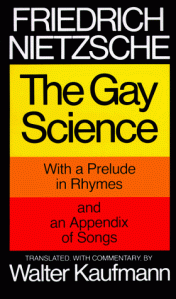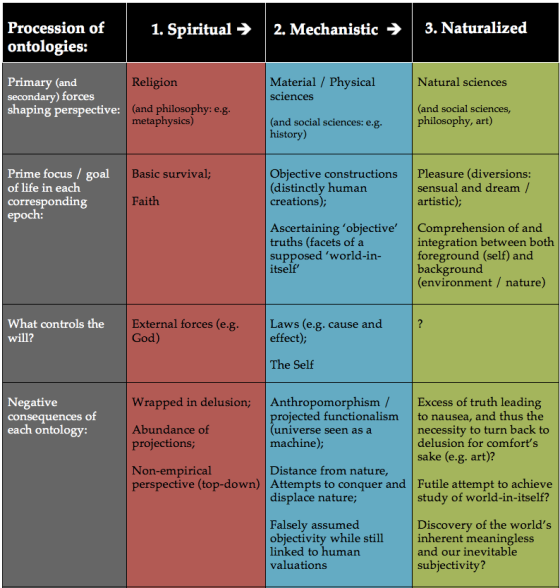Tag Archives: Friedrich Nietzsche
Towards a Naturalized Ontology: Jung’s Psychological Assessment of the Receeding of Religious Projections
While Friedrich Nietzsche pronounced the death of God and critically examined the replacement ontology that followed from a philosophical perspective, Carl Jung provided a psychological perspective for the philosophical paradigm shift towards a de-spiritualized ontology. In Jung’s analysis of the shift from religion to science as the most prominent force in explaining the workings of the world, and man’s role in them, he brings into account the psychological notion of projections. Continue reading
Towards a Naturalized Ontology: Nietzsche’s Death of God and Critique of the Mechanistic Perspective that Follows
In this series, starting with Friedrich Nietzsche’s proclamation of God’s death, I’ll examine the shift towards what could be described as a naturalized understanding of the world — an interpretation lacking in both the religious projections of the spiritual era and the lingering anthropocentric projections of the following scientific, or mechanistic, ontology. Drawing from the works of Nietzsche, Jung, and other thinkers I’ll then propose my own analysis of the progression of naturalization, and how it can be arrived at…
‘God is dead’
In order to interpret man’s relationship with the world around him, both in terms of projection and distinction, the monumental shift from the metaphysical, religious perspective to the naturalized perspective should first be charted, including its most significant event: the death of God. Nietzsche wrote in The Gay Science (full text PDF here) that “God is dead,” and we humans are his murderer (GS Sec. 125). “God” in this case isn’t a personal deity but the God of civilization — the defining explanatory force for how the world operates. According to Nietzsche, the death of God leads to the positive effects of allowing solitude, re-valuation of good things due to the decline of morality (GS Sec. 292), and a dismissal of faith, which once aroused nausea (GS Sec. 76). However, the death of God also leads to “metaphysical need” (GS Sec. 151). The death of God is an indication of the receding of the shadow of religion from its reign over human consciousness — that is, the reduction in the use of religious explanations for how the universe operates and our roles in it. Continue reading
Art and Self-Definition
Art is the subjective modification of the empirical world in a media format, typically inspired, as most personal creations are, by a person’s subjective experience in the world. Humans are constantly creating their own proprietary — though interconnected — worlds through a process of information gathering through their senses —> processing such information through thought —> creating a mental framework for action. Art pushes such modification into the physical realm, perhaps even manifesting in forms humans use in a utilitarian manner to make sense of the world, such as language or pictorial representation. Thus, perceptions are channeled into a form of mental representation, even informing the concept of such things as are perceived, like Plato’s idea of Forms. In turn these representations can be imposed upon a format in its physical manifestation, be it a painter’s canvas, a singer’s voice, a story in a magazine… Continue reading
Nietzsche’s Self-Styling, or How to Become an Aesthetic Phenomenon
Friedrich Nietzsche identifies art as a way to gain perspective on our existence and ease existential nausea, writing in Gay Science 107 (full text available here), “As an aesthetic phenomenon existence is still bearable to us,” creating a front between us and the “nausea and suicide” we realize due to honesty. Honesty (and thus nausea) finds its source in the realization of the inherent meaninglessness of the world of appearances as its witnessed through science and empirical observation — the naturalized perspective Nietzsche argued for throughout his work — instead of a religious lens. Nietzsche’s human is “filled with Dionysian joy and pride in his own artistry,” because without intrinsic order he is led to “the absence of a designing god [leading in turn] to a heightened joy in the artistic possibility of man” (Nussbaum 58). Art helps to bridge the gap between the role of religious order and the chaos that comes once the order is revealed as a delusion (see: “God is dead”); however, the art cannot just exist for its own sake. Art — the right kind of art — and an adaptation of its techniques in the creation of our own identities allows some room for optimism about the human condition because it permits us to create meaning.

An issue remains: Exactly how can we make ourselves into an “aesthetic phenomenon,” as Nietzsche writes in GS 107? The primary solution is self-styling: the use of artistic techniques to craft the self. To make the world, including the self, into an aesthetic phenomenon, not just must the techniques of artists must be copied, but their effects must be integrated into the self as well. Thus, not just the world but the self must be made aesthetic (Young 99). Artistic means are able to achieve this through self-styling, which allows self-deception and artistic perspective, countering honesty and meaninglessness.
